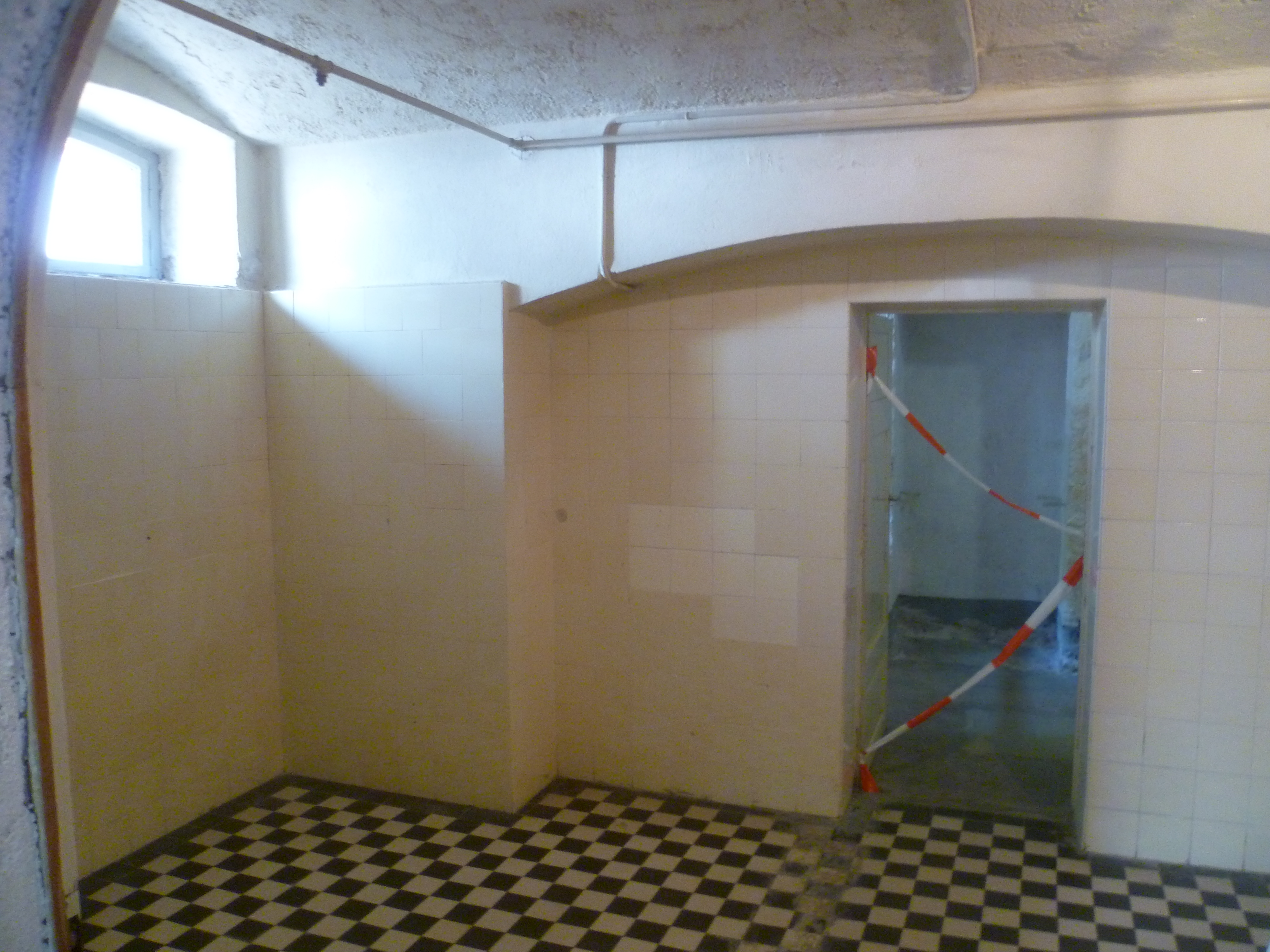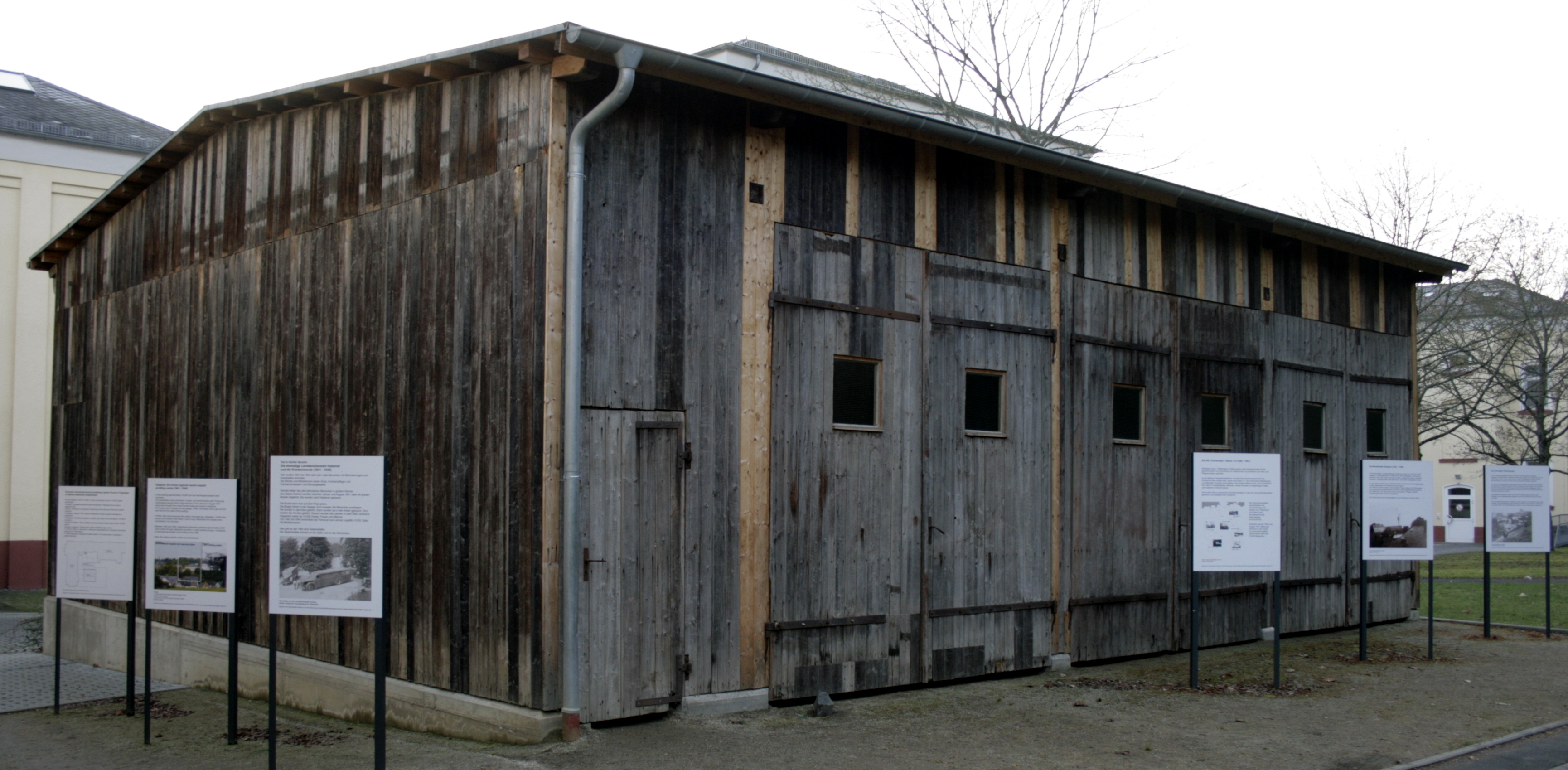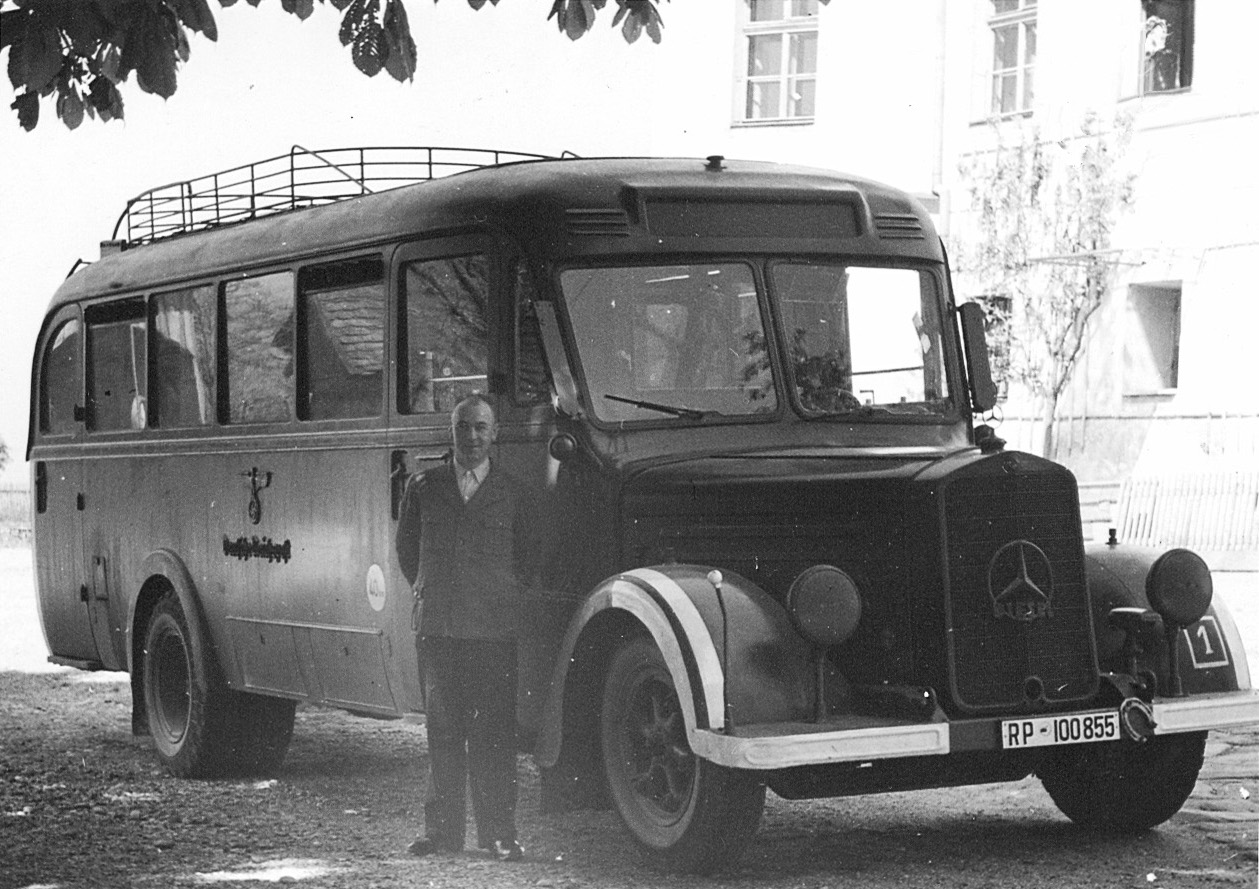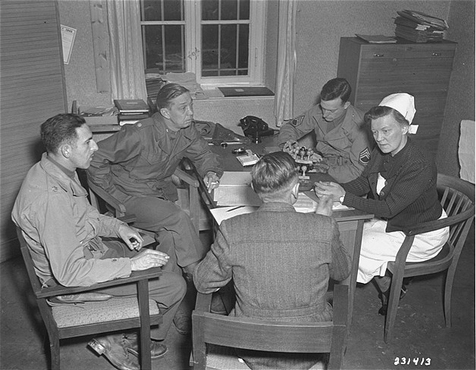Hadamar Euthanasia Centre on:
[Wikipedia]
[Google]
[Amazon]

 The Hadamar killing centre (german: NS-Tötungsanstalt Hadamar) was a killing facility involved in the
The Hadamar killing centre (german: NS-Tötungsanstalt Hadamar) was a killing facility involved in the


 Since the late 19th century, doctors and scientists had been developing theories of racial purity based on
Since the late 19th century, doctors and scientists had been developing theories of racial purity based on
 As people learned of these activities, especially the role of the "grey buses" in collecting victims, there was growing opposition. Fearing public unrest, Hitler officially announced in August 1941 that the "euthanasia" activities had been curtailed.
As people learned of these activities, especially the role of the "grey buses" in collecting victims, there was growing opposition. Fearing public unrest, Hitler officially announced in August 1941 that the "euthanasia" activities had been curtailed.

 The Hadamar Trial, 8–15 October 1945, was the first mass atrocity trial in the American occupation zone of Germany following World War II. In the first months of occupation, American military forces had conducted trials based on classical violations of international law, principally for the German murders of captured Allied service personnel, which had occurred in the last months of the war. The discovery in late March 1945 of the "euthanasia" facility Hadamar near
The Hadamar Trial, 8–15 October 1945, was the first mass atrocity trial in the American occupation zone of Germany following World War II. In the first months of occupation, American military forces had conducted trials based on classical violations of international law, principally for the German murders of captured Allied service personnel, which had occurred in the last months of the war. The discovery in late March 1945 of the "euthanasia" facility Hadamar near
 The Hadamar killing centre (german: NS-Tötungsanstalt Hadamar) was a killing facility involved in the
The Hadamar killing centre (german: NS-Tötungsanstalt Hadamar) was a killing facility involved in the Nazi
Nazism ( ; german: Nazismus), the common name in English for National Socialism (german: Nationalsozialismus, ), is the far-right totalitarian political ideology and practices associated with Adolf Hitler and the Nazi Party (NSDAP) in ...
"involuntary euthanasia
Involuntary euthanasia occurs when euthanasia is performed on a person who would be able to provide informed consent, but does not, either because they do not want to die, or because they were not asked.
Involuntary euthanasia is contrasted with ...
" programme known as ''Aktion T4
(German, ) was a campaign of mass murder by involuntary euthanasia in Nazi Germany. The term was first used in post- war trials against doctors who had been involved in the killings. The name T4 is an abbreviation of 4, a street address o ...
''. It was housed within a psychiatric hospital
Psychiatric hospitals, also known as mental health hospitals, behavioral health hospitals, are hospitals or wards specializing in the treatment of severe mental disorders, such as schizophrenia, bipolar disorder, eating disorders, dissociat ...
located in the German town of Hadamar
Hadamar is a small town in Limburg-Weilburg district in Hesse, Germany.
Hadamar is known for its Clinic for Forensic Psychiatry/Centre for Social Psychiatry, lying at the edge of town, in whose outlying buildings is also found the Hadamar Mem ...
, near Limburg in Hessen
Hesse (, , ) or Hessia (, ; german: Hessen ), officially the State of Hessen (german: links=no, Land Hessen), is a state in Germany. Its capital city is Wiesbaden, and the largest urban area is Frankfurt. Two other major historic cities are Darms ...
.
Beginning in 1939, the Nazis
Nazism ( ; german: Nazismus), the common name in English for National Socialism (german: Nationalsozialismus, ), is the far-right totalitarian political ideology and practices associated with Adolf Hitler and the Nazi Party (NSDAP) in N ...
used Hadamar and five other sites as killing facilities for ''Aktion T4'', which performed mass sterilizations and mass murder of "undesirable" members of German society, specifically those with physical and mental disabilities. In total, an estimated 200,000 people were murdered at these facilities, including thousands of children. These actions were in keeping with Nazi ideas about eugenics. While officially ended in 1941, the programme lasted until the German surrender in 1945. Nearly 15,000 German citizens were transported to the hospital and murdered there, most by gas chamber and the rest by lethal injection and starvation. In addition, hundreds of forced labourers from Poland and other countries occupied by the Nazis were murdered there.
Hadamar and its hospital fell within the American occupation zone
Germany was already de facto occupied by the Allies from the real fall of Nazi Germany in World War II on 8 May 1945 to the establishment of the East Germany on 7 October 1949. The Allies (United States, United Kingdom, Soviet Union, and Franc ...
after the war. During 8–15 October 1945, United States forces conducted the Hadamar Trial, the first mass atrocity trial in the years following World War II. They prosecuted doctors and staff on charges of murdering citizens of allied countries, namely, forced labourers from Poland
Poland, officially the Republic of Poland, is a country in Central Europe. It is divided into 16 administrative provinces called voivodeships, covering an area of . Poland has a population of over 38 million and is the fifth-most populou ...
and other countries. The US had jurisdiction for these crimes under international law. Several people were convicted and executed for these crimes. After the German courts were reconstructed under the occupation, in 1946 a doctor and nurse were prosecuted by Germans for the murders of nearly 15,000 German citizens at the hospital. Both were convicted.
The hospital continues to operate. It holds a memorial to the euthanasia murders as well as an exhibit about the Nazi programme.
Background

eugenics
Eugenics ( ; ) is a fringe set of beliefs and practices that aim to improve the genetic quality of a human population. Historically, eugenicists have attempted to alter human gene pools by excluding people and groups judged to be inferior o ...
, a concept popular at the time that developed from several disciplines including social history, biology, anthropology and genetics. As Weindling (1989) explained, there had been several movements in Germany since the end of World War I
World War I (28 July 1914 11 November 1918), often abbreviated as WWI, was List of wars and anthropogenic disasters by death toll, one of the deadliest global conflicts in history. Belligerents included much of Europe, the Russian Empire, ...
concerned with the 'degeneration' of German racial purity that culminated with the founding in 1927 of the Kaiser Wilhelm Institute of Anthropology, Human Heredity, and Eugenics
The Kaiser Wilhelm Institute of Anthropology, Human Heredity, and Eugenics was founded in 1927 in Berlin, Germany. The Rockefeller Foundation partially funded the actual building of the Institute and helped keep the Institute afloat during the Gr ...
. Although there had been demands since the early 1920s for legislation on sterilization
Sterilization may refer to:
* Sterilization (microbiology), killing or inactivation of micro-organisms
* Soil steam sterilization, a farming technique that sterilizes soil with steam in open fields or greenhouses
* Sterilization (medicine) rende ...
and euthanasia
Euthanasia (from el, εὐθανασία 'good death': εὖ, ''eu'' 'well, good' + θάνατος, ''thanatos'' 'death') is the practice of intentionally ending life to eliminate pain and suffering.
Different countries have different eut ...
, these were rejected because it was believed that positive eugenics was more representative of the Weimar political structures and the nation's social needs. This approach ended in 1933 after the ascent of the Nazis in Germany, who implemented a eugenics programme based on their pseudoscientific racial theories.
In July 1933, the Nazis passed the "Law for the Prevention of Hereditarily Diseased Offspring
Law for the Prevention of Genetically Diseased Offspring (german: Gesetz zur Verhütung erbkranken Nachwuchses) or "Sterilisation Law" was a statute in Nazi Germany enacted on July 14, 1933, (and made active in January 1934) which allowed the com ...
", which prescribed compulsory sterilisation
Compulsory sterilization, also known as forced or coerced sterilization, is a government-mandated program to involuntarily sterilize a specific group of people. Sterilization removes a person's capacity to reproduce, and is usually done throug ...
for people with medical conditions thought to be hereditary, such as schizophrenia and "imbecility". It is estimated that 360,000 people were sterilised under this law between 1933 and 1939.
First phase of ''Aktion T4''
Beginning in late 1939, Hitler personally issued an order on his private stationery authorizingPhilipp Bouhler
Philipp Bouhler (11 September 1899 – 19 May 1945) was a German senior Nazi Party functionary who was both a (National Leader) and Chief of the Chancellery of the Führer of the NSDAP. He was also the SS official responsible for the euthanas ...
and Karl Brandt to initiate a "euthanasia" programme to give the "incurably sick" a "mercy death". Developed by Viktor Brack
Viktor Hermann Brack (9 November 1904 – 2 June 1948) was a member of the ''Schutzstaffel'' (SS) and a convicted Nazi war criminal, who was one of the prominent organisers of the euthanasia programme Aktion T4; this Nazi initiative resulted in the ...
, it began with mass sterilizations of children deemed "unfit" to reproduce. After that, the hospital staff exterminated children determined to be unfit and the programme was later expanded to adults. By January 1940, the Nazis had set up their first killing facilities. The clinic in Hadamar, which housed a psychiatric facility, was the last of six facilities set up to implement the programme, with murders commencing in January 1941. In the eight months of the first phase of the murder operations (January to August 1941), 10,072 men, women and children were asphyxiated with carbon monoxide
Carbon monoxide ( chemical formula CO) is a colorless, poisonous, odorless, tasteless, flammable gas that is slightly less dense than air. Carbon monoxide consists of one carbon atom and one oxygen atom connected by a triple bond. It is the simpl ...
in a gas chamber
A gas chamber is an apparatus for killing humans or other animals with gas, consisting of a sealed chamber into which a poisonous or asphyxiant gas is introduced. Poisonous agents used include hydrogen cyanide and carbon monoxide.
History
...
as part of the Nazi "euthanasia" programme. The gas was obtained in standard cylinders supplied by the chemicals company IG Farben
Interessengemeinschaft Farbenindustrie AG (), commonly known as IG Farben (German for 'IG Dyestuffs'), was a German chemical and pharmaceutical conglomerate. Formed in 1925 from a merger of six chemical companies— BASF, Bayer, Hoechst, Agf ...
.
Thick smoke from the hospital crematorium billowed over Hadamar in the summer of 1941, during which the staff celebrated the cremation of their 10,000th patient with beer and wine.
Up to 100 victims arrived in post-buses every day. They were told to disrobe for a "medical examination". Sent before a physician, each was recorded as having one of 60 fatal diseases, as "incurables" were to be given a "mercy death". The doctor identified each person with different-coloured sticking plaster
An adhesive bandage, also called a sticking plaster, medical plaster, or simply plaster in British English, is a small medical dressing used for injuries not serious enough to require a full-size bandage. They are also known by the genericized tr ...
s for one of three categories: murder; murder & remove brain for research; murder & extract gold teeth.
Families of the victims were sent "comfort letters" with falsified causes of death. Families could also request a funerary urn
An urn is a vase, often with a cover, with a typically narrowed neck above a rounded body and a footed pedestal. Describing a vessel as an "urn", as opposed to a vase or other terms, generally reflects its use rather than any particular shape or ...
, but the ashes were not from their family member.
Protests
Despite the hospital's precautions to cover up the T-4 programme, the local population were fully aware of events at the hospital. The people murdered in the Hadamar hospital were brought in by train and bus, apparently vanishing behind the site's high fencing. Since thecrematorium
A crematorium or crematory is a venue for the cremation of the dead. Modern crematoria contain at least one cremator (also known as a crematory, retort or cremation chamber), a purpose-built furnace. In some countries a crematorium can also b ...
ovens were more often than not fed with two corpses at a time, the cremation process was less than perfect. This often resulted in the aforementioned thick, acrid smog
Smog, or smoke fog, is a type of intense air pollution. The word "smog" was coined in the early 20th century, and is a portmanteau of the words '' smoke'' and ''fog'' to refer to smoky fog due to its opacity, and odor. The word was then int ...
hanging over the town. According to a letter sent by Bishop Antonius Hilfrich
Antonius Hilfrich (also Anton Hilfrich; 3 October 1873 – 5 February 1947) was a German priest and Roman Catholic Bishop of Limburg, Germany.
Ordained in 1898, in March 1930 he was appointed Coadjutor Bishop of Limburg and Titular Bishop of Se ...
of the Diocese of Limburg to the Reich Justice Minister in August 1941, local children taunted each other with the words "You're not very clever; you will go to Hadamar and into the ovens".
 As people learned of these activities, especially the role of the "grey buses" in collecting victims, there was growing opposition. Fearing public unrest, Hitler officially announced in August 1941 that the "euthanasia" activities had been curtailed.
As people learned of these activities, especially the role of the "grey buses" in collecting victims, there was growing opposition. Fearing public unrest, Hitler officially announced in August 1941 that the "euthanasia" activities had been curtailed.
Second phase of ''Aktion T4''
After nearly a year of suspension, the murder of 'undesirables' resumed in August 1942, in what has been termed the "decentralized euthanasia" phase of ''Aktion T4'', where "euthanasia" killings were committed without centralized coordination from Berlin. Resident physicians and staff, headed by nurseIrmgard Huber
Irmgard Huber (1901–1983) was the head nurse at the Hadamar Killing Facility. Beginning in late 1939, it was operated as one of six major centers for Action T4, a secret sterilization and "involuntary euthanasia" program in Nazi Germany. Nearly ...
, directly murdered the majority of these victims, among whom were German patients with disabilities, mentally-disoriented elderly persons from bombed-out areas, "half Jewish" children from welfare institutions, psychologically- and physically-disabled forced labourers and their children, German soldiers, and ''Waffen SS
The (, "Armed SS") was the combat branch of the Nazi Party's ''Schutzstaffel'' (SS) organisation. Its formations included men from Nazi Germany, along with volunteers and conscripts from both occupied and unoccupied lands.
The grew from th ...
'' soldiers deemed psychologically incurable. Because the gas chamber had been deconstructed, the medical personnel and staff at Hadamar murdered almost all of these people by lethal drug overdoses or deliberate neglect and malnutrition.
Though the war ended in Germany on 8 May 1945, the Nazi extermination institutions continued to murder disabled patients by drugs or depriving them of food. The last known patient murdered at Hadamar was a four-year-old mentally handicapped boy, killed on 29 May 1945.
During the second "decentralized" phase of ''Aktion T4'', an estimated 4,500 victims were murdered at Hadamar.
On 26 March 1945, the US 2nd Infantry Division captured the town of Hadamar
Hadamar is a small town in Limburg-Weilburg district in Hesse, Germany.
Hadamar is known for its Clinic for Forensic Psychiatry/Centre for Social Psychiatry, lying at the edge of town, in whose outlying buildings is also found the Hadamar Mem ...
and American officials began to investigate the murders that had been committed at its hospital.
Hadamar Trial

 The Hadamar Trial, 8–15 October 1945, was the first mass atrocity trial in the American occupation zone of Germany following World War II. In the first months of occupation, American military forces had conducted trials based on classical violations of international law, principally for the German murders of captured Allied service personnel, which had occurred in the last months of the war. The discovery in late March 1945 of the "euthanasia" facility Hadamar near
The Hadamar Trial, 8–15 October 1945, was the first mass atrocity trial in the American occupation zone of Germany following World War II. In the first months of occupation, American military forces had conducted trials based on classical violations of international law, principally for the German murders of captured Allied service personnel, which had occurred in the last months of the war. The discovery in late March 1945 of the "euthanasia" facility Hadamar near Limburg an der Lahn
Limburg an der Lahn (officially abbreviated ''Limburg a. d. Lahn'') is the district seat of Limburg-Weilburg in Hesse, Germany.
Geography
Location
Limburg lies in western Hessen between the Taunus and the Westerwald on the river Lahn.
The t ...
in west central Germany riveted attention in the United States, with many local newspapers describing it as a "murder factory".
U.S. military authorities decided to undertake their first prosecution to adjudicate crimes associated with the systematic racial and social persecution and extermination committed under Nazi Germany policies. Initially, American authorities intended to try Hadamar physicians, nurses, and administrative staff in their custody for the murders of nearly 15,000 German patients at the institution. At the time, however, they lacked jurisdiction to do so under international law. U.S. military officials could not try German nationals for murdering their fellow citizens. International law restricted them to prosecute crimes committed against their own service personnel and civilian nationals, and those of their allies, in the territories that they held.
Among the Hadamar victims were 476 Soviet and Polish forced labourers. Identified as having tuberculosis
Tuberculosis (TB) is an infectious disease usually caused by '' Mycobacterium tuberculosis'' (MTB) bacteria. Tuberculosis generally affects the lungs, but it can also affect other parts of the body. Most infections show no symptoms, ...
, they were transported to Hadamar and murdered at the hospital in the last months of the war. As these civilian forced laborers were citizens of countries allied to the United States, American prosecutors were able to open proceedings against seven Hadamar defendants associated with the murders of the "Eastern workers". On 15 October 1945, chief United States prosecutor Leon Jaworski (who later gained prominence in the 1970s as Watergate
The Watergate scandal was a major political scandal in the United States involving the administration of President Richard Nixon from 1972 to 1974 that led to Nixon's resignation. The scandal stemmed from the Nixon administration's continu ...
Special Prosecutor), won convictions for all the accused. The six-man U.S. military tribunal sentenced the Hadamar chief administrator Alfons Klein, and two male nurses, Heinrich Ruoff and Karl Willig, to death by hanging. Chief physician Adolf Wahlmann
Adolf (also spelt Adolph or Adolphe, Adolfo and when Latinised Adolphus) is a given name used in German-speaking countries, Scandinavia, the Netherlands and Flanders, France, Italy, Spain, Portugal, Latin America and to a lesser extent in vari ...
received a life sentence with hard labor due to his old age (he was nearly 70) and poor health. Two Hadamar administrative staff received sentences of 35 and 30 years with hard labor, respectively. Irmgard Huber
Irmgard Huber (1901–1983) was the head nurse at the Hadamar Killing Facility. Beginning in late 1939, it was operated as one of six major centers for Action T4, a secret sterilization and "involuntary euthanasia" program in Nazi Germany. Nearly ...
, a nurse and only female defendant, received the lightest sentence, that of 25 years imprisonment with hard labor. On 14 March 1946, Klein, Ruoff, and Willig were executed.
In December 1945 the Allies promulgated Allied Control Council Law No. 10, which allowed the elastic charge of "crimes against humanity
Crimes against humanity are widespread or systemic acts committed by or on behalf of a ''de facto'' authority, usually a state, that grossly violate human rights. Unlike war crimes, crimes against humanity do not have to take place within the ...
" to cover the massive scale of extermination the Germans had carried out against Jews, Poles, Gypsies and other populations. This charge was introduced in the indictment by the International Military Tribunal
International is an adjective (also used as a noun) meaning "between nations".
International may also refer to:
Music Albums
* ''International'' (Kevin Michael album), 2011
* ''International'' (New Order album), 2002
* ''International'' (The T ...
(IMT) at Nuremberg
Nuremberg ( ; german: link=no, Nürnberg ; in the local East Franconian dialect: ''Nämberch'' ) is the second-largest city of the German state of Bavaria after its capital Munich, and its 518,370 (2019) inhabitants make it the 14th-largest ...
.
In early 1946, "euthanasia" crimes such as those at Hadamar were transferred to the German courts, newly reconstructed under the occupation. In early 1947, a German tribunal in Frankfurt
Frankfurt, officially Frankfurt am Main (; Hessian: , " Frank ford on the Main"), is the most populous city in the German state of Hesse. Its 791,000 inhabitants as of 2022 make it the fifth-most populous city in Germany. Located on it ...
tried 25 Hadamar personnel, including Wahlmann and Huber, for the murder of some 15,000 German patients at the facility. Although some had their sentences increased, they were all released early in the 1950s.
Post-war use of the site
Today, the site houses a psychiatric hospital, the ''Vitos Klinik für Psychiatrie und Psychotherapie Hadamar'', alongside the Hadamar Memorial Museum, which contains a memorial to the victims and an exhibition regarding the mass murders that took place on the site. Both the clinic and museum are operated by the State of Hessen.See also
*Nazi eugenics
Nazi eugenics refers to the social policies of eugenics in Nazi Germany, composed of various pseudoscientific ideas about genetics. The racial ideology of Nazism placed the biological improvement of the German people by selective breeding of ...
*Gemeinnützige Krankentransport GmbH
The Gemeinnützige Krankentransport GmbH (; known as ''"Gekrat"'' or ''"GeKraT"'', commonly translated as "Charitable Ambulance") was a subdivision of the Action T4 organization. The euphemistically named company transported sick and disabled peop ...
*Am Spiegelgrund clinic
Am Spiegelgrund was a children's clinic in Vienna during World War II, where 789 patients were murdered under child euthanasia in Nazi Germany. Between 1940 and 1945, the clinic operated as part of the psychiatric hospital Am Steinhof later kno ...
*Hartheim killing centre
The Hartheim killing centre (german: NS-Tötungsanstalt Hartheim, sometimes translated as "Hartheim killing facility" or "Hartheim euthanasia centre") was a killing facility involved in the Nazi programme known as ''Aktion T4'', in which German ...
* Hans Asperger
References
External links
* * *Notes
:''This article incorporates text from theUnited States Holocaust Memorial Museum
The United States Holocaust Memorial Museum (USHMM) is the United States' official memorial to the Holocaust. Adjacent to the National Mall in Washington, D.C., the USHMM provides for the documentation, study, and interpretation of Holocaust h ...
, and has been released under the GFDL
The GNU Free Documentation License (GNU FDL or simply GFDL) is a copyleft license for free documentation, designed by the Free Software Foundation (FSF) for the GNU Project. It is similar to the GNU General Public License, giving readers th ...
.''
{{Authority control
Aktion T4 euthanasia centres
Psychiatric hospitals in Germany
Hospitals in Germany
Hospitals established in 1941
Medical and health organisations based in Hesse